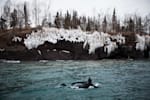Strong northeasterly winds, -20C temperatures, and lingering flurries make for a bone-chilling afternoon down at the Scarborough Bluffs.
Whilst weather advisories urge staying indoors, longtime lake surfer Larry Cavero wrestles into his cold-weather wetsuit, waxes up his board, and rushes into the lineup with only one thing in mind: the seven-foot peeling A-frame that breaks in front of him.
“Harsh weather brings energy, and energy makes waves,” says Cavero. “When the elements align, perfect waves can emerge along our frigid coastlines, producing remarkable size, punch, and shape — it really is a miracle.”
For Cavero and other experienced lake surfers, riding a world-class caliber wave isn’t all fantasy. But, knowing when and where the ride will take place can take countless hours of analyzing wind and swell charts, while concurrently scrolling through hundreds of kilometres of shoreline via Google Earth, in search of points, coves, jetties, and piers that may produce a sheltered, glossy wave.
Long story short, lake surfing isn’t easy. However, with the right level of commitment, a determined surfer could be out riding waves at least three times a week between September and April.
Think you’ve got what it takes? With the help of Cavero, we’ve assembled a guide that answers some of the most common questions regarding lake surfing, like how waves are formed, what equipment is needed to surf them, and some tips and tricks to get started.
How a lake produces swell
Similarly to the swell-forming phenomenon observed in the ocean, surface waves are created in lakes by wind-induced friction. As wind blows over a calm lake surface, it creates a rippling texture. Molecules of moving air are being pushed by the breeze, causing them to rub against the surface of the water and move some water molecules on the same direction as the wind. A few molecules start moving and they collide with others to set them in motion. As the air keeps moving, so does the water. This creates waves.
Wave height is affected by wind speed, wind duration (how long the wind blows), and fetch, which is the distance over water that the wind blows in a single direction. Larger surf-able waves only occur when all three factors combine.
In most cases, lakes are confined to smaller fetches which limit wave size, but the Great Lakes are large enough to produce frequent swells up to several metres. However, the highest ever recorded waves were 8.7 metres, outside of Marquette, Michigan, on Lake Superior.
Most storms in the Great Lakes region move from west to east as a result of the polar jet stream. Since Lake Erie, Superior, and Ontario are oriented in the same direction as the path of most storms, each lake’s eastern shoreline can expect more swell because the winds can blow across the water for a greater distance.
When you have the whole length of the lake to create energy, it creates much punchier waves.
Knowing when the waves are pumping
“Ideally, once September starts and the temperatures begin to drop, 25km/h+ winds that blow for at least three to four hours will create swell,” said Cavero.
Since wind is essential to produce swell, lake surfing is best during the colder, windier months of the year. This is because wind is created by temperate differences between air masses that lead to great pressure differences. As well, air and water temperature play a key role. Colder, denser air, can more easily manipulate warmer, malleable water, creating more energy.
While one can predict that winds will increase in the colder months, the eastern shorelines will receive more consistent swell year-round, and October brings large eastern storms that light up the Toronto region, Cavero says that “you have to become a freak when it comes to reading wind directions in order to score good waves.”
Apps like WindFinder, Windy, WeatherCAN, or NOAA forecasting systems will tell you accurate wind speeds, wave height, directions, air temperature, as well as animated wind maps to map fetch. Windfinder for instance provides weather forecasts up ten days into the future.
Knowing where the waves are pumping
If you’ve determined the swell direction and wave height, it should lead you to an area of coastline most susceptible to swell. Through experimentation, or reaching out and joining a local surf community like Surf The Greats or Cavero’s own Surf Dreams Canada, you’re bound to find a popular hot spot.
But for Cavero, a lot of the thrill involved in lake surfing comes with the search. The Great Lakes host a combined shoreline of roughly 17,700 kilometres and is littered with points, wedges, coves, jetties, river mouths, and piers, all with the potential of producing a fun wave. It’s a great opportunity to explore your backyard.
What to expect
“Be prepared to face the elements, and battle through shorter periods,” says Cavero.
Due to the lakes limited size, surfers are often out during and experiencing the harsh conditions that create the waves themselves. This means that the optimal time to surf is windy, cold, and sometimes snowing, hailing, or raining. This is when a thick wetsuit (5/4 mm or 6/5 mm) paired with boots and mitts comes in handy.
As well, wind-induced swell often generates much shorter periods between waves. This means that full wave lengths occur over less time, often creating less powerful, choppier conditions.
“Once you get over the shorter periods and unfavourable conditions, then you’re having a blast,” Cavero added.

Dressed for the weather. ✅
© Klein / Red Bull Content Pool






Recent Comments